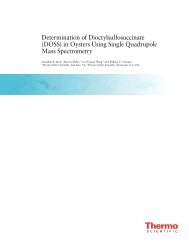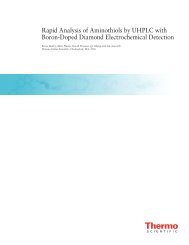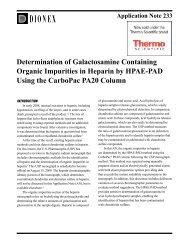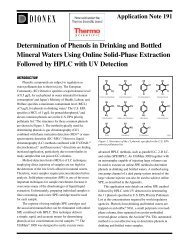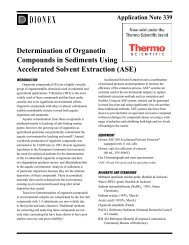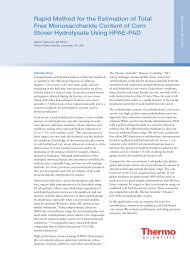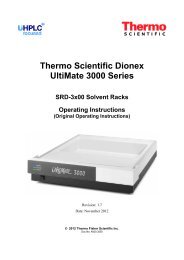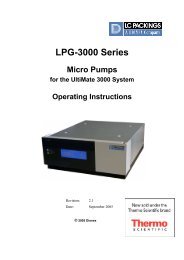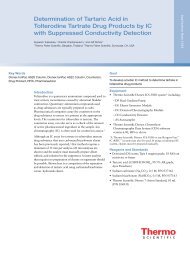Extraction of Polychlorinated dibenzo-p-dioxins and ... - Dionex
Extraction of Polychlorinated dibenzo-p-dioxins and ... - Dionex
Extraction of Polychlorinated dibenzo-p-dioxins and ... - Dionex
Create successful ePaper yourself
Turn your PDF publications into a flip-book with our unique Google optimized e-Paper software.
Application Note 323<br />
<strong>Extraction</strong> <strong>of</strong> <strong>Polychlorinated</strong> Dibenzo-p-<strong>dioxins</strong><br />
<strong>and</strong> <strong>Polychlorinated</strong> Dibenz<strong>of</strong>urans from<br />
Environmental Samples Using Accelerated<br />
Solvent <strong>Extraction</strong> (ASE)<br />
Meets the requirements <strong>of</strong> U.S. EPA Method 3545<br />
IntroductIon<br />
Regulatory agencies are concerned with the high<br />
toxicity <strong>of</strong> polychlorinated <strong>dibenzo</strong>-p-<strong>dioxins</strong> (PCDDs)<br />
<strong>and</strong> polychlorinated dibenz<strong>of</strong>urans (PCDFs); great efforts<br />
are expended to monitor their presence in environmental<br />
samples. The low concentrations at which these<br />
compounds are regulated <strong>and</strong> the strength <strong>of</strong> their binding<br />
to certain matrices pose special challenges to analytical<br />
chemists. The most commonly used extraction procedure<br />
is Soxhlet extraction. It is time-consuming (typically 18 to<br />
36 h) <strong>and</strong> requires large volumes <strong>of</strong> solvent (250 to<br />
500 mL). An alternative method is warranted.<br />
Accelerated Solvent <strong>Extraction</strong> (ASE ® ) is equivalent<br />
to U.S. EPA Methods 3540, 3541, <strong>and</strong> 8150 for the<br />
extraction <strong>of</strong> organochlorine pesticides (OCPs),<br />
organophosphorus pesticides (OPPs), semivolatiles<br />
or base, neutral, acids (BNA), chlorinated herbicides,<br />
polycyclic aromatic hydro carbons (PAHs), <strong>and</strong><br />
polychlorinated biphenyls (PCBs). ASE complies with<br />
U.S. EPA Method 3545 for these com pounds. ASE<br />
is a technique that uses liquid solvents at elevated<br />
temperatures <strong>and</strong> pressures. These conditions allow<br />
extractions to take place in short periods <strong>of</strong> time with<br />
small solvent volumes as compared to conventional<br />
techniques such as sonication <strong>and</strong> Soxhlet extraction. For<br />
example, a 10 gram sample can typically be extracted<br />
by ASE in less than 15 min with less than 15 mL <strong>of</strong><br />
solvent as compared to several hours <strong>and</strong> several hundred<br />
milliliters <strong>of</strong> solvent with Soxhlet. ASE has been applied<br />
to the extraction <strong>of</strong> PCDDs <strong>and</strong> PCDFs from ground<br />
chimney brick, urban dust, fly ash, <strong>and</strong> sediment samples;<br />
the results are reported here.<br />
EQuIPMEnt<br />
<strong>Dionex</strong> ASE 200 Accelerated Solvent Extractor*<br />
Gas chromatograph (GC) equipped with mass<br />
spec trom eter (MS) (low resolution or high<br />
resolution MS-MS)<br />
Low pressure LC system for sample cleanup<br />
Preparative HPLC for sample cleanup<br />
*ASE 150 <strong>and</strong> 350 can be used for equivalent results.<br />
solvEnts<br />
Toluene, pesticide grade<br />
Acetic acid, reagent grade<br />
Hydrochloric acid, reagent grade<br />
All solvents are available from Fisher Scientific.<br />
saMPlE InforMatIon<br />
Two sample sets were investigated: one from<br />
Germany that included chimney brick, urban dust, <strong>and</strong><br />
fly ash, <strong>and</strong> a second from Canada that included four<br />
sediment samples. A sediment sample (EC-2) containing<br />
high ng/kg levels (ppt) <strong>of</strong> PCDDs <strong>and</strong> PCDFs was<br />
obtained from the National Water Research Institute (867<br />
Lakeshore Road, P.O. Box 5050, Burlington, Ontario,<br />
L7R 4A6, Canada). A low-level sediment sample (HS-2)<br />
was obtained from the National Research Council Institute<br />
for Marine Biosciences (1411 Oxford Street, Halifax,<br />
Nova Scotia, B3H 3Z1, Canada). Both samples are being<br />
investigated as potential st<strong>and</strong>ard reference materials<br />
<strong>and</strong> were used as received. Two other sediment samples<br />
(Parrots Bay <strong>and</strong> Hamilton Harbor) were extracted. Both<br />
have high levels <strong>of</strong> coextractable materials.
EXtractIon condItIons<br />
Table 1 lists the conditions used for the extraction <strong>of</strong><br />
the chimney brick <strong>and</strong> urban dust by Soxhlet <strong>and</strong> ASE.<br />
Table 1. <strong>Extraction</strong> Conditions for<br />
Chimney Brick <strong>and</strong> Urban Dust<br />
Condition Soxhlet ASE*<br />
Sample Size 4–10 g 4–10 g<br />
Solvent Toluene, 250 mL Toluene, 15 mL<br />
Temperature
One is calculated according to a formula from the North<br />
Atlantic Treaty Organization (NATO) <strong>and</strong> the other is<br />
from the German health organization BgVV. As can be<br />
seen, ASE shows equivalency to the Soxhlet method for<br />
recovery <strong>of</strong> these compounds.<br />
Fly Ash<br />
Table 2. Average Values (ng/kg) from Ground<br />
Chimney Brick—Comparison <strong>of</strong> Soxhlet vs. ASE<br />
Group Totals Soxhlet (n=1) ASE a (n=2)<br />
Total T CDD 4 440 530<br />
Total P CDD 5 900 940<br />
Total H CDD 6 1800 2000<br />
Total H CDD 7 2000 2100<br />
Total O CDD 8 2900 2600<br />
Total T CDF 4 2300 2600<br />
Total P CDF 5 4100 4300<br />
Total H CDF 6 4700 4700<br />
Total H CDF 7 2800 2600<br />
Total O CDF 8 2000 2000<br />
Congeners Soxhlet (n=1) ASE a (n=2)<br />
2,3,7,8-T CDD 4 6.0 6.0<br />
1,2,3,7,8-P CDD 5 52 57<br />
1,2,3,4,7,8-H CDD 6 46 52<br />
1,2,3,6,7,8-H CDD 6 120 130<br />
1,2,3,7,8,9-H CDD 6 97 1000<br />
1,2,3,4,6,7,8-H CDD 7 1000 820<br />
2,3,7,8-T CDF 4 160 180<br />
1,2,3,7,8(+1,2,3,4,8)-P CDF 5 430 470<br />
2,3,4,7,8-P CDF 5 390 390<br />
1,2,3,4,7,8(+1,2,3,4,7,9)-H CDF 6 1100 1100<br />
1,2,3,6,7,8-H CDF 6 540 570<br />
2,3,4,6,7,8-H CDF 6 400 360<br />
1,2,3,7,8,9-H CDF 6 42 42<br />
1,2,3,4,6,7,8-H CDF 7 2100 2000<br />
1,2,3,4,7,8,9-H CDF 7 140 120<br />
Toxicity equivalent (NATO) 540 540<br />
Toxicity equivalent (BgVV) 490 510<br />
Values are corrected for recovery <strong>of</strong> 13 C-labeled surrogates.<br />
a Sum <strong>of</strong> two extractions <strong>of</strong> each sample.<br />
The results from the extractions <strong>of</strong> the fly ash are<br />
listed in Table 4. The units for this sample are µg/kg<br />
because the sample was so highly contaminated. ASE<br />
results are equiva lent to those from Soxhlet extractions<br />
when the HCl/water pretreatment was used.<br />
Table 5 shows the data from the fly ash extractions when<br />
Table 3. Average Values (ng/kg) from Urban<br />
Dust—Comparison <strong>of</strong> Soxhlet vs. ASE<br />
Group Totals Soxhlet (n=1) ASE a (n=2)<br />
Total T CDD 4 182 325<br />
Total P CDD 5 175 221<br />
Total H CDD 6 86.7 81.7<br />
Total H CDD 7 221 217<br />
Total O CDD 8 445 314<br />
Total T CDF 4 333 419<br />
Total P CDF 5 146 179<br />
Total H CDF 6 65.9 122<br />
Total H CDF 7 13.2 29.4<br />
Total O CDF 8 n.d. (10) n.d. (10)<br />
Congeners Soxhlet (n=1) ASE a (n=2)<br />
2,3,7,8-T CDD 4 3.3 3.2<br />
1,2,3,7,8-P CDD 5 11.8 13.1<br />
1,2,3,4,7,8-H CDD 6 9.8 8.0<br />
1,2,3,6,7,8-H CDD 6 11.5 9.5<br />
1,2,3,7,8,9-H CDD 6 n.d. (8) n.d. (8)<br />
1,2,3,4,6,7,8-H CDD 7 113 107<br />
2,3,7,8-T CDF 4 12.5 18.6<br />
1,2,3,7,8(+1,2,3,4,8)-P CDF 5 9.9 12.0<br />
2,3,4,7,8-P CDF 5 13.9 18.1<br />
1,2,3,4,7,8(+1,2,3,4,7,9)-H CDF 6 18.7 23.7<br />
1,2,3,6,7,8-H CDF 6 10.7 15.8<br />
2,3,4,6,7,8-H CDF 6 3.3 8.7<br />
1,2,3,7,8,9-H CDF 6 n.d. (2) n.d. (2)<br />
1,2,3,4,6,7,8-H CDF 7 13.2 29.4<br />
1,2,3,4,7,8,9-H CDF 7 n.d. (3) n.d. (3)<br />
Toxicity equivalent (NATO) 25.0 28.7<br />
Toxicity equivalent (BgVV) 24.2 29.2<br />
Values are corrected for recovery <strong>of</strong> 13 C-labeled surrogates.<br />
n.d.=not detected. Detection limit, in ppt, given in parentheses.<br />
a Sum <strong>of</strong> two extractions <strong>of</strong> each sample.<br />
Application Note 323 3
acetic acid was added to the toluene for the extractions<br />
by ASE. The results with the acetic acid are a little lower<br />
than with the HCl pretreatment, but the recovery is still<br />
close to 96% <strong>of</strong> that <strong>of</strong> Soxhlet, making ASE essentially<br />
identical to Soxhlet for these compounds.<br />
Table 4. Average Values (µg/kg) from Fly Ash a<br />
Comparison <strong>of</strong> Soxhlet vs. ASE (HCl Pretreatment)<br />
Group Totals Soxhlet (n=1) ASE b (n=2)<br />
Total T CDD 4º 12.0 12.4<br />
Total P CDD 5 16.6 20.5<br />
Total H CDD 6 38.2 42.4<br />
Total H CDD 7 15.0 19.8<br />
Total O CDD 8 11.4 12.8<br />
Total T CDF 4 60.5 67.5<br />
Total P CDF 5 83.5 87.3<br />
Total H CDF 6 65.2 73.5<br />
Total H CDF 7 28.1 32.2<br />
Total O CDF 8 13.5 15.8<br />
Congeners Soxhlet (n=1) ASE b (n=2)<br />
2,3,7,8-T CDD 4 0.32 0.36<br />
1,2,3,7,8-P CDD 5 1.6 2.1<br />
1,2,3,4,7,8-H CDD 6 1.2 1.4<br />
1,2,3,6,7,8-H CDD 6 2.4 2.7<br />
1,2,3,7,8,9-H CDD 6 2.4 2.3<br />
1,2,3,4,6,7,8-H CDD 7 8.2 9.6<br />
2,3,7,8-T CDF 4 3.7 4.3<br />
1,2,3,7,8(+1,2,3,4,8)-P CDF 5 4.2 4.6<br />
2,3,4,7,8-P CDF 5 5.6 6.6<br />
1,2,3,4,7,8(+1,2,3,4,7,9)-H CDF 6 7.8 8.7<br />
1,2,3,6,7,8-H CDF 6 7.2 8.5<br />
2,3,4,6,7,8-H CDF 6 6.6 7.2<br />
1,2,3,7,8,9-H CDF 6 0.43 0.56<br />
1,2,3,4,6,7,8-H CDF 7 18.0 17.6<br />
1,2,3,4,7,8,9-H CDF 7 2.3 2.4<br />
Toxicity equivalent (NATO) 7.6 8.9<br />
Toxicity equivalent (BgVV) 7.3 14.2<br />
Values are corrected for recovery <strong>of</strong> 13 C-labeled surrogates.<br />
a Pretreatment with HCl for 30 min followed by water rinse.<br />
b Sum <strong>of</strong> two extractions <strong>of</strong> each sample.<br />
High-Level Sediment Samples<br />
A comparison <strong>of</strong> average results for the Soxhlet <strong>and</strong><br />
ASE methods for the high-level sediment sample (EC-2)<br />
is presented in Table 6. The data compare very favorably.<br />
Discrepancies were found to exist mostly with the group<br />
total data. For example, despite having found more<br />
isomers in the T 4 CDF <strong>and</strong> P 5 CDF congener groups<br />
with ASE, the total values were lower than the Soxhletbased<br />
data.<br />
Table 5. Average Values (µg/kg) from Fly Ash a<br />
Comparison <strong>of</strong> Soxhlet a vs. ASE b<br />
Group Totals Soxhlet (n=1) ASE c (n=2)<br />
Total T CDD 4 12.0 10.5<br />
Total P CDD 5 16.6 16.2<br />
Total H CDD 6 38.2 36.7<br />
Total H CDD 7 15.0 16.0<br />
Total O CDD 8 11.4 10.6<br />
Total T CDF 4 60.5 56.1<br />
Total P CDF 5 83.5 77.4<br />
Total H CDF 6 65.2 46.1<br />
Total H CDF 7 28.1 26.5<br />
Total O CDF 8 13.5 13.9<br />
Congeners Soxhlet (n=1) ASE c (n=2)<br />
2,3,7,8-T CDD 4 0.32 0.28<br />
1,2,3,7,8-P CDD 5 1.6 1.7<br />
1,2,3,4,7,8-H CDD 6 1.2 1.2<br />
1,2,3,6,7,8-H CDD 6 2.4 2.4<br />
1,2,3,7,8,9-H CDD 6 2.4 2.2<br />
1,2,3,4,6,7,8-H CDD 7 8.2 8.1<br />
2,3,7,8-T CDF 4 3.7 3.4<br />
1,2,3,7,8(+1,2,3,4,8)-P CDF 5 4.2 3.9<br />
2,3,4,7,8-P CDF 5 5.6 5.8<br />
1,2,3,4,7,8(+1,2,3,4,7,9)-H CDF 6 7.8 5.4<br />
1,2,3,6,7,8-H CDF 6 7.2 5.3<br />
2,3,4,6,7,8-H CDF 6 6.6 4.5<br />
1,2,3,7,8,9-H CDF 6 0.43 0.30<br />
1,2,3,4,6,7,8-H CDF 7 18.0 16.8<br />
1,2,3,4,7,8,9-H CDF 7 2.3 2.0<br />
Toxicity equivalent (NATO) 7.6 7.0<br />
Toxicity equivalent (BgVV) 7.3 6.3<br />
Values are corrected for recovery <strong>of</strong> 13 C-labeled surrogates.<br />
a Pretreatment with HCl for 30 min followed by water rinse for Soxhlet samples.<br />
b No HCl pretreatment, <strong>and</strong> toluene/acetic acid solvent used for ASE samples.<br />
c Sum <strong>of</strong> two extractions <strong>of</strong> each sample.<br />
4 <strong>Extraction</strong> <strong>of</strong> <strong>Polychlorinated</strong> Dibenzo-p-<strong>dioxins</strong> <strong>and</strong> <strong>Polychlorinated</strong> Dibenz<strong>of</strong>urans from<br />
Environmental Samples Using Accelerated Solvent <strong>Extraction</strong> (ASE)
These differences may be attributable to sample<br />
heterogeneity. The surrogate recoveries for the two<br />
tech niques (averaged over the entire data set) were 78%<br />
with Soxhlet <strong>and</strong> 70% using ASE. Losses arising from<br />
the cleanup processes were predictably the same (54%<br />
average cleanup st<strong>and</strong>ard recovery for the Soxhlet data<br />
<strong>and</strong> 63% for the ASE data). The comparison <strong>of</strong> the<br />
recovery <strong>of</strong> the specific congeners as shown in Table 6 is<br />
very good.<br />
Group Totals<br />
The data for sample HS-2 show similar trends<br />
(Table 7). The specific congeners are once again in<br />
excellent agreement for the two techniques, but the group<br />
results by ASE are lower than those by Soxhlet.<br />
Average surrogate recoveries were 75% using Soxhlet <strong>and</strong><br />
73% using ASE. Cleanup st<strong>and</strong>ard recoveries were 56%<br />
(Soxhlet) <strong>and</strong> 66% (ASE).<br />
Table 6. Average Values (ng/kg) from EC-2—Comparison <strong>of</strong> Soxhlet vs. ASE<br />
Soxhlet <strong>Extraction</strong> (n=10) Accelerated Solvent <strong>Extraction</strong> (n=2)<br />
Value % RSD Isomers Value % RSD Isomers<br />
Total T CDD 4 430 9.7 8 370 1.9 9<br />
Total P CDD 5 300 3.7 11 280 7.7 11<br />
Total H CDD 6 720 5.8 7 690 2.0 7<br />
Total H CDD 7 1300 7.0 2 1300 0.0 2<br />
Total O CDD 8 4000 6.2 1 4200 0.0 1<br />
Total T CDF 4 620 12 17 380 19 19<br />
Total P CDF 5 820 9.4 14 710 7.0 17<br />
Total H CDF 6 1900 5.7 12 1900 0.0 13<br />
Total H CDF 7 3800 8.2 4 3900 3.6 4<br />
Total O CDF 8 7800 8.3 1 7000 3.1 1<br />
Congeners Value % RSD % Recovery a Value % RSD % Recovery a<br />
2,3,7,8-T CDD 4 270 9.1 68 270 0.0 72<br />
1,2,3,7,8-P CDD 5 24 12 74 22 3.3 81<br />
1,2,3,4,7,8-H CDD 6 23 8.3 76 24 3.0 80<br />
1,2,3,6,7,8-H CDD 6 83 3.6 78 87 0.8 54<br />
1,2,3,7,8,9-H CDD 6 60 6.2 77 57 7.4 67<br />
1,2,3,4,6,7,8-H CDD 7 720 6.7 81 720 1.0 79<br />
2,3,7,8-T CDF 4 b 100 7.3 68 82 2.6 70<br />
1,2,3,7,8-P CDF 5 39 14 74 36 3.9 76<br />
2,3,4,7,8-P CDF 5 62 5.5 79 60 0.0 75<br />
1,2,3,4,7,8-H CDF 6 740 5.3 81 690 0.0 70<br />
1,2,3,6,7,8-H CDF 6 120 6.2 81 120 0.0 50<br />
2,3,4,6,7,8-H CDF 6 45 9.0 82 60 1.2 69<br />
1,2,3,7,8,9-H CDF 6 4.9 31 84 5.3 15 70<br />
1,2,3,4,6,7,8-H CDF 7 2600 6.7 85 2500 0.0 74<br />
1,2,3,4,7,8,9-H CDF 7 160 5.5 83 160 0.0 72<br />
Values are corrected for recovery <strong>of</strong> 13 C-labeled surrogates.<br />
a Refers to recovery <strong>of</strong> corresponding 13 C-labeled surrogate.<br />
b Maximum possible concentration due to potential chromatographic overlap.<br />
Application Note 323 5
Highly Contaminated Sediment Samples<br />
The ASE technique was also evaluated with two<br />
sediment samples containing high levels <strong>of</strong> coextractables<br />
<strong>and</strong> oil (Table 8). Aliquots <strong>of</strong> these samples were taken<br />
Group Totals<br />
from a larger container as quan tita tively as possible<br />
but were not nearly as homogeneous as the rigorously<br />
prepared reference materials.<br />
Recoveries were outside <strong>of</strong> control limits (25 to 150%)<br />
for T 4 CDF <strong>and</strong> P 5 CDF Hamilton Harbor ASE data,<br />
Table 7. Average Values (ng/kg) from HS-2—Comparison <strong>of</strong> Soxhlet vs. ASE<br />
Soxhlet <strong>Extraction</strong> (n=4) Accelerated Solvent <strong>Extraction</strong> (n=2)<br />
Value % RSD Isomers Value % RSD Isomers<br />
Total T CDD 4 3.9 14 2 2.5 34 5<br />
Total P CDD 5 17 7.8 6 10 10 9<br />
Total H CDD 6 510 5.6 8 570 1.3 7<br />
Total H CDD 7 4700 8.3 2 5100 11 2<br />
Total O CDD 8 6500 4.2 1 7100 0.0 1<br />
Total T CDF 4 39 11 13 24 3.0 14<br />
Total P CDF 5 33 13 8 28 0.0 11<br />
Total H CDF 6 89 3.2 6 87 12 10<br />
Total H CDF 7 293 3.3 4 310 0.0 4<br />
Total O CDF 8 300 3.8 1 280 2.6 1<br />
Congeners Value % RSD % Recovery a Value % RSD % Recovery a<br />
2,3,7,8-T CDD 4 n.d. (1) 62 n.d. (1) 71<br />
1,2,3,7,8-P CDD 5 1.6 4.6 69 n.d. (1) 75<br />
1,2,3,4,7,8-H CDD 6 4.5 4.8 74 5.2 11 73<br />
1,2,3,6,7,8-H CDD 6 19 4.3 75 21 0.0 50<br />
1,2,3,7,8,9-H CDD 6 24 4.3 74 28 2.6 61<br />
1,2,3,4,6,7,8-H CDD 7 1200 8.1 80 1300 0.0 93<br />
2,3,7,8-T CDF 4 b 8.5 11 62 6.6 5.4 65<br />
1,2,3,7,8-P CDF 5 1.9 17 68 2.0 0.0 72<br />
2,3,4,7,8-P CDF 5 3.7 7.9 71 3.7 3.8 59<br />
1,2,3,4,7,8-H CDF 6 17 7.3 79 17 4.3 70<br />
1,2,3,6,7,8-H CDF 6 3.7 5.6 80 4.0 5.4 49<br />
2,3,4,6,7,8-H CDF 6 3.7 18 81 4.4 3.2 61<br />
1,2,3,7,8,9-H CDF 6 n.d. (1) 83 n.d. (1) 0.0 75<br />
1,2,3,4,6,7,8-H CDF 7 91 1.6 83 96 3.7 82<br />
1,2,3,4,7,8,9-H CDF 7 5.2 6.7 84 5.3 6.7 83<br />
n.d.=not detected. Detection limit, in ppt, given in parentheses. Values not used for statistical calculations.<br />
Values are corrected for recovery <strong>of</strong> 13 C-labeled surrogates.<br />
a Refers to recovery <strong>of</strong> corresponding 13 C-labeled surrogate.<br />
b Maximum possible concentration due to potential chromatographic overlap.<br />
6 <strong>Extraction</strong> <strong>of</strong> <strong>Polychlorinated</strong> Dibenzo-p-<strong>dioxins</strong> <strong>and</strong> <strong>Polychlorinated</strong> Dibenz<strong>of</strong>urans from<br />
Environmental Samples Using Accelerated Solvent <strong>Extraction</strong> (ASE)
which likely accounts for the differences in these data<br />
points when compared to the Soxhlet extraction. Similar<br />
differences in the group total data were observed for the<br />
Parrots Bay samples (e.g., T 4 CDF), but no recoveryrelated<br />
problems were observed in this case. Generally,<br />
the data compare favorably between ASE <strong>and</strong> Soxhlet for<br />
the recovery <strong>of</strong> PCDDs <strong>and</strong> PCDFs from these heavily<br />
contaminated sediments.<br />
Group Totals<br />
Recommended ASE Conditions for PCDDs <strong>and</strong> PCDFs<br />
Based on the results <strong>of</strong> these experiments, the<br />
conditions listed in Table 9 are recommended for the<br />
extraction <strong>of</strong> polychlorinated <strong>dibenzo</strong>-p-<strong>dioxins</strong> <strong>and</strong><br />
polychlorinated dibenz<strong>of</strong>urans. The conditions may have<br />
to be adjusted slightly to optimize extraction efficiency<br />
depending on the sample. Increasing the temperature<br />
would be the first parameter to change; increasing the<br />
extraction time would be next.<br />
Table 8. Average Values (ng/kg) from Highly Contaminated Sources—Comparison <strong>of</strong> Soxhlet vs. ASE<br />
Hamilton Harbor Parrots Bay<br />
Soxhlet ASE Soxhlet ASE<br />
Total T CDD 4 505 142 393 485 Total P CDD 5 6312 155 8710 6610 Total H CDD 6 2207 1807 2306 2007 Total H CDD 7 8502 8102 5802 5302 Total O CDD 8 3100 3100 1900 1600<br />
Total T CDF 4 37017 13011a 40014 27018 Total P CDF 5 29013 11011a 1808 17013 Total H CDF 6 24014 16011 2306 23010 Total H CDF 7 3504 2904 4004 3604 Total O CDF 8 270 210 510 370<br />
Congeners<br />
2,3,7,8-T CDD 4 3.7 3.1 19 19<br />
1,2,3,7,8-P CDD 5 5.1 5.4 8.3 6.0<br />
1,2,3,4,7,8-H CDD 6 6.4 7.2 8.6 6.7<br />
1,2,3,6,7,8-H CDD 6 27 26 26 17<br />
1,2,3,7,8,9-H CDD 6 20 28 24 18<br />
1,2,3,4,6,7,8-H CDD 7 460 430 280 250<br />
2,3,7,8-T CDF 4 b 61 44a 80 48<br />
1,2,3,7,8-P CDF 5 14 14 n.d. (20) 9.8<br />
2,3,4,7,8-P CDF 5 26 25a 22 14<br />
1,2,3,4,7,8-H CDF 6 27 37 79 59<br />
1,2,3,6,7,8-H CDF 6 17 16 n.d. (20) 15<br />
2,3,4,6,7,8-H CDF 6 14 14 21 11<br />
1,2,3,7,8,9-H CDF 6 n.d. (2) 1.6 4.9 n.d. (1)<br />
1,2,3,4,6,7,8-H CDF 7 130 130 270 220<br />
1,2,3,4,7,8,9-H CDF 7 14 13 17 12<br />
Values are corrected for recovery <strong>of</strong> isotopically labeled surrogate st<strong>and</strong>ards.<br />
n.d.=not detected. Detection limit, in ppt, given in parentheses.<br />
Superscripts indicate the number <strong>of</strong> isomers detected.<br />
a Recoveries outside the range 25% to 150%; results are not to be used for regulatory compliance purposes.<br />
b Maximum possible concentration due to potential chromatographic overlap.<br />
Application Note 323 7
conclusIons<br />
The data show that ASE is essentially equivalent to<br />
classical extraction procedures such as Soxhlet for the<br />
extraction <strong>of</strong> PCDDs <strong>and</strong> PCDFs from environmental<br />
matrices. As an extraction technique, ASE shows great<br />
promise because it can be applied to a wide variety <strong>of</strong><br />
compound classes. In addition to being equivalent to<br />
Soxhlet, ASE can be performed in a fraction <strong>of</strong> the time<br />
(a total <strong>of</strong> 22 min compared to 18 h) <strong>and</strong> with much less<br />
solvent (15 mL compared to 250 mL).<br />
Solvent<br />
Table 9. Recommended Conditions for<br />
ASE <strong>Extraction</strong> <strong>of</strong> PCDDs <strong>and</strong> PCDFs<br />
Toluene or toluene/acetic acid (5%, v/v)<br />
if HCl pretreatment currently used<br />
Temperature 175–200 ˚C<br />
Pressure 13.8 MPa (2000 psi)<br />
Static Time 5–15 min<br />
Flush Volume 60–70%<br />
Purge Time 60–100 s<br />
Number <strong>of</strong> Static Cycles 2 or 3<br />
Speed • Simplicity • Solutions<br />
<strong>Dionex</strong> Corporation<br />
1228 Titan Way<br />
P.O. Box 3603<br />
Sunnyvale, CA<br />
94088-3603<br />
(408) 737-0700<br />
North America<br />
U.S./Canada (847) 295-7500<br />
South America<br />
Brazil (55) 11 3731 5140<br />
Europe<br />
Austria (43) 1 616 51 25 Benelux (31) 20 683 9768; (32) 3 353 4294<br />
Denmark (45) 36 36 90 90 France (33) 1 39 30 01 10 Germany (49) 6126 991 0<br />
Irel<strong>and</strong> (353) 1 644 0064 Italy (39) 02 51 62 1267 Sweden (46) 8 473 3380<br />
Switzerl<strong>and</strong> (41) 62 205 9966 United Kingdom (44) 1276 691722<br />
acKnoWlEdGMEnts<br />
The contributions <strong>of</strong> David S. Waddell, Tereza<br />
Gobran, <strong>and</strong> Vin Khurana from the Ontario Ministry <strong>of</strong><br />
Environment <strong>and</strong> Energy, Ontario, Canada, <strong>and</strong> <strong>of</strong> Dr.<br />
Scheutwinkel <strong>and</strong> Dr. Mattulat from Dr. Scheutwinkel<br />
GmbH, Berlin, Germany are acknowledged.<br />
rEfErEncEs<br />
1. “The Determination <strong>of</strong> <strong>Polychlorinated</strong> Dibenzop-<strong>dioxins</strong><br />
<strong>and</strong> Dibenz<strong>of</strong>urans in Soil <strong>and</strong> Sediment<br />
by GC-MS”; Method E3151B; Ontario Ministry <strong>of</strong><br />
Environment <strong>and</strong> Energy: 1993.<br />
ASE is a registered trademark <strong>of</strong> <strong>Dionex</strong> Corporation.<br />
TSQ is a registered trademark <strong>of</strong> Finnigan Corporation.<br />
Asia Pacific<br />
Australia (61) 2 9420 5233 China (852) 2428 3282 India (91) 22 2764 2735<br />
Japan (81) 6 6885 1213 Korea (82) 2 2653 2580 Singapore (65) 6289 1190<br />
Taiwan (886) 2 8751 6655<br />
www.dionex.com<br />
LPN 0812-04 PDF 6/11<br />
©2011 <strong>Dionex</strong> Corporation




